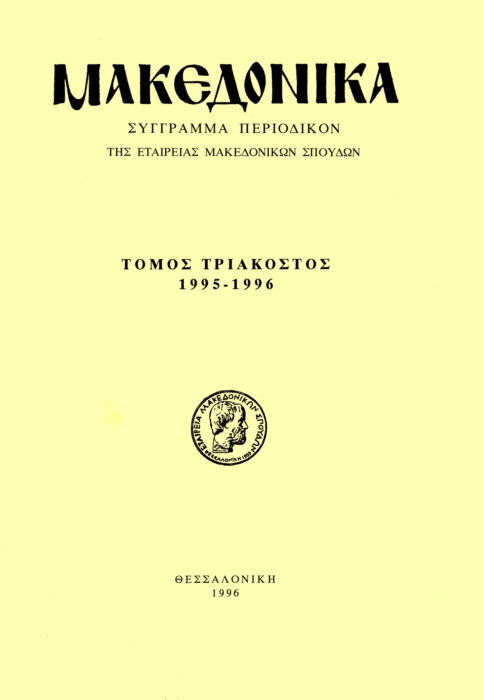Sgraffito ware from Arhondiko, Pella prefecture (1995 excavation)
Abstract
The sgraffito ware published in this study was found in 1994 in the prehistoric settlement at Arhondiko, Pella prefecture. The collection com prises 73 sherds and two complete vessels from the settlement’s first habi tation phase, which is dated, on the basis of radiocarbon dates, to 2118-1937 BC —i.e. the start of the second millennium or the middle of the Bronze Age.
All the material is handmade and the fabric is usually pure, though non plastic elements (mica) are also found. We start by examining the technique by which the decorative subjects were incised on the vessels. Seven incising methods are distinguishable, according to the tool used in each case. We believe the tools must have been made of bone, stone, or flat pieces of metal. The vessels include small phiales with elevated wishbone handles, amphoras, cantharus-like vessels, and cups. The motifs are geometrical shapes (triangles, lozenges, circles, surrounds).
The material from Arhondiko shares similarities with material found in Central Macedonia (Axiohori (phase B), Kalindria II, the Lebet Tumulus at Polihni, Toumba in Thessaloniki, Gona, Perivolaki 2) and dated by Heurtley to the middle of the Bronze Age. With this in mind, together with other excavational data presented in this study, we have dated the Arhondiko material to the mid-Bronze Age, i.e. the early second millennium.
Article Details
- How to Cite
-
Μερούσης Ν., Μποβολή Α., & Στεφανή Α. (1996). Sgraffito ware from Arhondiko, Pella prefecture (1995 excavation). Makedonika, 30(1), 189–228. https://doi.org/10.12681/makedonika.245
- Issue
- Vol. 30
- Section
- Articles

This work is licensed under a Creative Commons Attribution-NonCommercial-ShareAlike 4.0 International License.
Authors who publish with this journal agree to the following terms:
- Authors retain copyright and grant the journal right of first publication with the work simultaneously licensed under a Creative Commons Attribution Non-Commercial License that allows others to share the work with an acknowledgement of the work's authorship and initial publication in this journal.
- Authors are able to enter into separate, additional contractual arrangements for the non-exclusive distribution of the journal's published version of the work (e.g. post it to an institutional repository or publish it in a book), with an acknowledgement of its initial publication in this journal.
- Authors are permitted and encouraged to post their work online (preferably in institutional repositories or on their website) prior to and during the submission process, as it can lead to productive exchanges, as well as earlier and greater citation of published work (See The Effect of Open Access).



